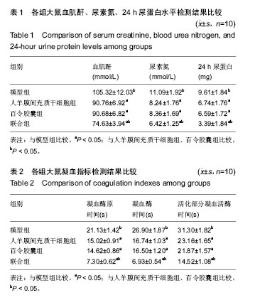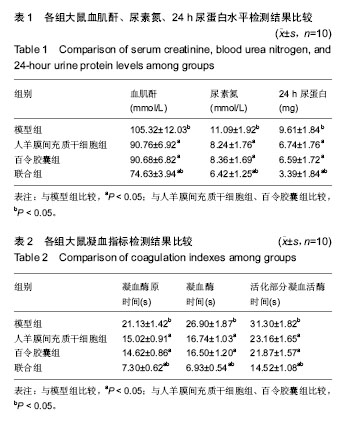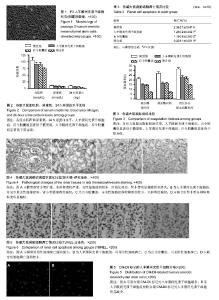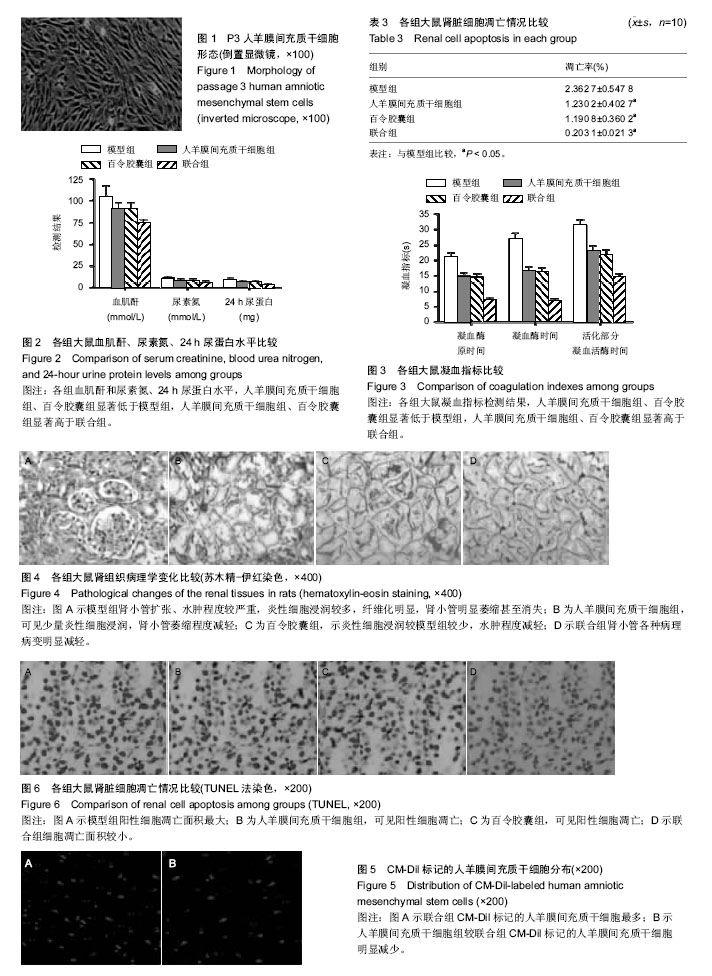| [1] Audard V, Lang P, Sahali D. [Minimal change nephrotic syndrome: new insights into disease pathogenesis]. Med Sci (Paris). 2008;24(10): 853-858.[2] Asanuma K,Yanagida-Asanuma E,Faul C,et al.Synaptopodin orchestrates actin organization and cell motility via regulation of RhoA signalling. Nat Cell Biol. 2006;8(5):485-491.[3] Mustafa G, Khan PA, Iqbal I, et al. Simplified quantification of urinary protein excretion in children with nephrotic syndrome. J Coll Physicians Surg Pak. 2007;17(10): 615-618.[4] Marshall SM. The podocyte: a potential therapeutic target in diabetic nephropathy. Curr Pharm Des. 2007;13(26):2713-2720.[5] Cunard R, Kelly CJ. T cells and minimal change disease. J Am Soc Nephrol. 2002;13(5): 1409-1411.[6] Grimbert P, Audard V, Remy P, et al. Recent approaches to the pathogenesis of minimal-change nephrotic syndrome. Nephrol Dial Transplant. 2003;18(2): 245-248.[7] Bruno S, Grange C, Deregibus MC, et al. Mesenchymal stem cell-derived microvesicles protect against acute tubular injury. J Am Soc Nephrol. 2009;20(5):1053-1067.[8] Oh J,Kemper MJ.Minimal change (steroid sensitive) nephrotic syndrome in children: new aspects on pathogenesis and treatment. Minerva Pediatr. 2012;64(2):197-204.[9] 陆晓东.百令胶囊治疗慢性肾衰的动物实验研究[J].实用中医内科杂志. 2004,18(6):507-508.[10] 方敬爱,邓安国,周明群,等.百令胶囊对糖尿病肾病大鼠生化指标及肾组织病理学改变的影响[J].中国中西医结合肾病杂志,2005, 6(11):629-632.[11] 黄勤,何俊卿.百令胶囊联合苯那普利治疗IgA肾病33例的临床观察[J].贵阳中医学院学报,2011,33(1):29-31.[12] 龚圆渊.六味地黄丸联合bFGF诱导骨髓间充质干细胞向神经元样细胞分化的研究[D].成都中医药大学,2012.[13] 孔根现. VEGF分别与bFGF、aFGF联合诱导骨髓间充质干细胞分化为血管内皮细胞[D].南方医科大学,2013.[14] Asanuma K,Anagida-Asanuma E,Faul C, et al. Synaptopodin orchestrates actin organization and cell motility via regulation of RhoA signalling. Nat Cell Biol. 2006;8(5): 485-491.[15] Mustafa G, Khan PA, Iqbal I, et al. Simplified quantification of urinary protein excretion in children with nephrotic syndrome. J Coll Physicians Surg Pak. 2007;17(10): 615-618.[16] 李保春,刘先峰,张懿,等.骨髓干细胞参与小鼠急性肾小管坏死修复的实验研究[J].中华肾脏病杂志,2006,22(11):664-668.[17] Lin F. Stem cells in kidney regeneration following acute renal injury. Pediatr Res. 2006;59(4 Pt 2): 74R-8R.[18] 李慧,孙凌云.间质干细胞的免疫调节及免疫治疗作用研究进展[J].中华医学杂志,2006,86(7):501-503.[19] 温凯棋,张跃蓉.人羊膜间充质干细胞分离培养的研究进展[J].世界临床医学,2016,10(9):133-134.[20] 袁博,陈昆仑,张岚, 等.大鼠骨髓间充质干细胞对RH-35肝癌细胞侵袭能力的影响[J].西安交通大学学报,2014,35(4):455-459.[21] 邹毓华.骨髓间充质干细胞对阿霉素肾病大鼠的保护作用及机制的研究[D].福建医科大学,2012.[22] 杨焕丹,董晨,关凤军,等.骨髓间充质干细胞移植对嘌呤霉素氨基核苷肾病大鼠足细胞修复作用的研究[J].中国当代儿科杂志, 2010,12(6):483-487.[23] Turnbull IR, Clark AT, Stromberg PE, et al. Effects of aging on the immunopathologic response to sepsis. Crit Care Med. 2009;37(3): 1018-1023.[24] Liu WH, Hei ZQ, Nie H, et al. Berberine ameliorates renal injury in streptozotocin-induced diabetic rats by suppression of both oxidative stress and aldose reductase.Chin Med J (Engl). 2008;121(8): 706-712.[25] 施勇,周梁,田洁, 等.携带大鼠胶质细胞源性神经营养因子基因慢病毒载体的构建及转染[J].中国眼耳鼻喉科杂志,2008, 8(5): 283-285.[26] 张文高,杨学军. SPIO在非吞噬细胞成像中的应用及研究进展[J].国际医学放射学杂志,2008,31(06):473-475.[27] 彭伟,刘郑荣,任昊,等.骨髓间充质干细胞促进大鼠IgA肾病修复[J].中华肾脏病杂志,2008,24(10):743-750.[28] 连梓敏,曹定睿,王泓源,等.丙泊酚对Wistar大鼠肝癌模型中Bax与Bcl-2表达的影响[J].中国医学创新,2014,(12):28-30.[29] 马晓燕,曹定睿.舒芬太尼对大鼠肝癌肝细胞Bax和Bcl-2的影响[D].山西医科大学,2014.[30] 钟文旗,戴宪国,冯彩琴,等.氟伐他汀联合百令胶囊防治肾小球硬化实验研究[J].疑难病杂志,2006,5(3):167-169.[31] 钟文旗,杨芦蓉,倪娜,等.氟伐他汀联合百令胶囊治疗原发性肾病综合征临床分析[J].医学文选,2005,24(5):671-672.[32] 黄国东,许健,姜云,等.复方仙草颗粒对IgA肾病肾小球硬化大鼠TGF-β/Smads信号通路的影响[J].时珍国医国药,2010, 21(11): 2822-2824.[33] 刘江,杨敏,杨金国,等.百令胶囊在肾移植受者慢性排斥中的作用[J].现代中西医结合杂志,2005,14(12);1583-1583. [34] 刘大伟.百令胶囊联合厄贝沙坦治疗糖尿病肾病微量蛋白尿的临床观察[J].医学信息,2015,10:275-275.[35] Togel F,Cohen A,Zhang P,et al.Autologous and allogeneic marrow stromal cells are safe and effective for the treatment of acute kidney injury. Stem Cells Dev. 2009;18(3):475-485.[36] Morigi M,Rota C,Montemurro T,et al.Life-sparing effect of human cord blood mesenchymal stem cells in experimental a-cute kidney injury. Stem Cells. 2010;28(3):513-522.[37] Chade AR,Zhu X,Lavi R, et al. Endothelial progenitor cells re-store renal function in chronic experimental renovascular disease. Circulation. 2009;119(4):547-557.[38] Iwasaki M, Adachi Y, Minamino K, et al. Mobilization of bone marrow cells by G-CSF rescues mice from cisplatin-induced renal failure, and M-CSF enhances the effects of G-CSF.J Am Soc Nephrol. 2005;16(3):658-666.[39] Patschan D, Krupincza K, Patschan S, et al.Dynamics of mobilization and homing of endothelial progenitor cells after acute renal ischemia:modulation by ischemic preconditioning. Am J Physiol Renal Physiol. 2006;291(1): 176-185.[40] Iwasaki M,Adachi Y,Minamino K,et al.Mobilization of bone marrow cells by G-CSF rescues mice from cisplatin-induced Renal failure,and M-CSF enhances the effects of G-CSF. Am Soc Nephrol. 2005;16(3):658-666.[41] Siegel N,Rosner M,Unbekandt M,et al.Contribution of human amniotic fluid stem cells to renal tissue formation depends on mTOR. Human Molecular Genetics.2010;19(17):3320-3331.[42] Togel F,Cohen A,Zhang P,et al.Autologous and allogeneic marrow stromal cells are safe and effective for the treatment of acute kidney injury. Stem Cells Dev. 2009;18(3):475-485.[43] Tsuda H,Yamahara K,Ishikane S,et al. Allogenic fetal membrane derived mesenchymal stem cells contribute to renal repair in experimental glomerulonephritis. Am J Physiol Renal Physiol. 2010;299(5):1004-1013.[44] Skak K,Kragh M,Hausman D, et al. Interleukin 21: combination strategies for cancer therapy.Nat Rev Drug Discov. 2008;7(3):231-240.[45] Bianco P, Robey PG, Simmons PJ. Mesenchymal stem cells: revisiting history, concepts, and assays. Cell Stem Cell. 2008; 2(4): 313-319. |



